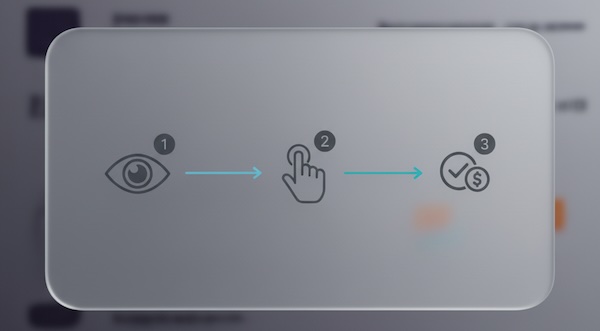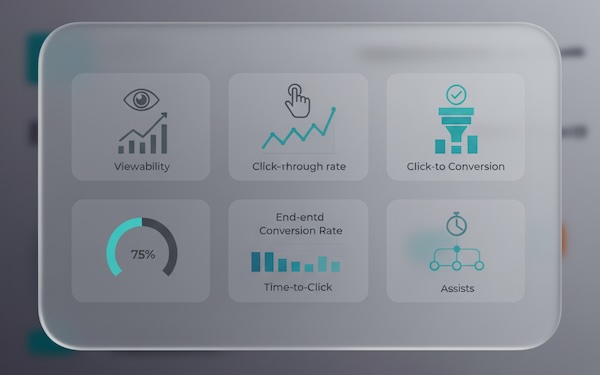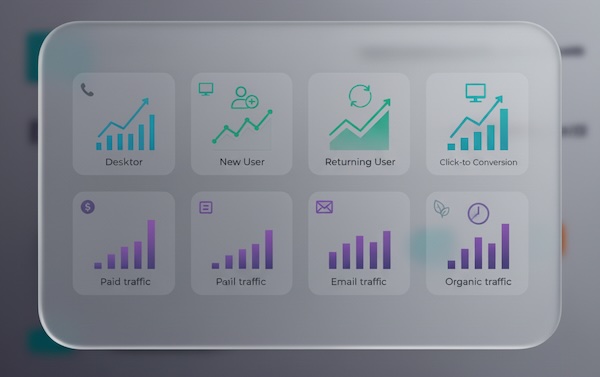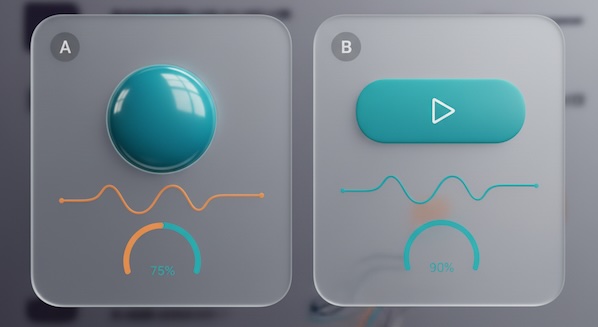Quick definitions (so we’re aligned)
If you’ve ever wondered “what is a CTA button” or even “what a call to action is,” think of it as the on-page element that explicitly asks the visitor to do something valuable—add to cart, start trial, request demo, subscribe. When people talk about “cta in marketing,” they mean designing and placing these prompts to move prospects through the funnel.
Pick one “Action KPI” first
Before dashboards and tests, choose a single action KPI per CTA. Make it the outcome the button exists to drive.
Examples:
- Product page “Add to Cart”: Add-to-Cart Rate (adds ÷ product page CTA impressions)
- Pricing page “Start Free Trial”: Trial Start Rate (trials ÷ pricing CTA impressions)
- Blog “Subscribe”: Subscriber Sign-up Rate (subs ÷ CTA impressions)
Tip: Use CTA impressions (how often the button was actually viewed) as the denominator, not total pageviews. This avoids bias from below-the-fold or hidden buttons.

Instrumentation that won’t paint you into a corner
Track one clean event for every CTA click (e.g., cta_click). Attach attributes so analysts can slice by context later:
cta_id(stable slug likepricing_primary)cta_text(e.g., “Start Free Trial”)page_typeandpage_urlplacement(hero, sticky, inline, modal)variant(A/B label if testing)visible(true/false—was ≥50% of the button visible for ≥1s before click?)device_type,traffic_source,campaign
Optional but powerful:
scroll_depthat impressiontime_to_click_mssession_engagement(pages/session or events before click)

The metrics that matter (and formulas)
Focus on a short list that connects behavior to business outcomes.
- CTA Viewability Rate
Impressions ÷ Pageviews
Shows how often visitors actually saw the button. Low viewability means design/placement, not copy, is the culprit. - View-to-Click Rate (CTR)
CTA Clicks ÷ CTA Impressions
Your primary responsiveness signal for the creative and copy. - Click-to-Conversion Rate
Primary Conversions (e.g., orders, trials) ÷ CTA Clicks
Confirms whether clicks are qualified, not just curious. - End-to-End Conversion Rate
Primary Conversions ÷ CTA Impressions
Rolls viewability, CTR, and quality into one number; ideal Action KPI. - Time to Click (median)
Seconds from impression to click. Faster isn’t always better—too fast can flag accidental taps on mobile. - Assisted Conversions from CTA Paths
Share of final conversions that included the CTA click in the session or user journey. Useful when the CTA is an intermediate step (e.g., “Learn More” on upper-funnel pages). - Error & Friction Rate
Rage clicks, validation errors post-CTA, dead-ends. If CTR rises but friction spikes, the experience breaks even (or worse).

Segments you should inspect every time
- Device & viewport: Mobile CTAs often need larger tap targets and sticky placement.
- New vs returning: Returning visitors may prefer “Log in”/“Resume checkout” CTAs; new users need “Learn More” or social proof first.
- Traffic source: Paid, email, and organic behave differently. Align CTA promise with acquisition intent.
- Placement variant: Hero vs inline vs sticky—measure, don’t guess.

Testing CTAs the right way (fast, rigorous, credible)
- Hypothesis structure: “Changing verb from ‘Submit’ to ‘Get My Quote’ will increase View-to-Click by 10% for pricing visitors in the US.”
- Guardrails: Don’t ship a CTR win that lowers revenue per session. Track both Click-to-Conversion and average order value/trial activation.
- Run length: Aim for 95% confidence and minimum detectable effect that’s practical (e.g., +8–12%). Stop early only for clear harm.
- Holdouts & persistence: If you use sticky or modal CTAs, verify the effect persists beyond novelty in a 2-phase test (A/B → multi-week holdout).
CTA best practices (backed by data, not lore)
These aren’t design commandments—they’re hypotheses that routinely test well. Use them as starting points and validate.
- Match intent, not just brand voice. Pricing pages: “Start Free Trial.” Comparison pages: “See Plans.” Blog posts: “Get the Checklist.”
- One primary action per view. Secondary links are okay, but avoid dueling primaries.
- Make benefits explicit. “Start Free Trial — 14 days, no card” beats “Submit.”
- Reduce surrounding friction. Fewer required form fields, predictable next step, social proof near the CTA.
- Mobile priority. Sticky footers and native tap affordances consistently lift End-to-End Conversion Rate on small screens.
(Yes, teams sometimes call the on-page optimization around CTAs “call to action SEO”—not because CTAs directly rank, but because better internal linking, improved engagement, and clearer pathways can support organic performance indirectly.)
Dashboard blueprint your execs will read
Organize your CTA dashboard around three questions: Did users see it? Did they act? Did it pay off?
See
- Pageviews
- CTA Impressions
- Viewability Rate
Act
- CTA Clicks
- View-to-Click Rate
- Time to Click (median)
Pay off
- Click-to-Conversion Rate
- End-to-End Conversion Rate (Action KPI)
- Assisted Conversions share
- Revenue/Trial starts per 1000 impressions
Add standard filters (device, source/medium, country, page type, variant). Save 3–5 curated views (e.g., “Mobile Pricing,” “Blog Subscribe,” “Cart Recovery”) for stakeholders.
Common pitfalls that skew CTA analysis
- Using pageviews as the denominator. You’ll undervalue below-the-fold CTAs or pages with long content. Use impressions.
- Counting accidental clicks as wins. Watch Time to Click, rage clicks, and bounce-after-click.
- Blending intents. A “Book a Demo” on a thought-leadership page will underperform by design; segment by page type.
- Not deduping users. For logged-in flows, evaluate user-level conversion alongside session-level to catch repeat clickers.
- Attribution confusion. Pair CTA metrics with your broader analytics and AI stack or model to understand where the click sits in the journey; last-click alone rarely tells the story.

Putting it together
- Define one Action KPI per CTA.
- Track impressions, clicks, and final outcomes with rich context.
- Read the “see → act → pay off” ladder in a single view.
- Test changes with guardrails and segments.
- Keep a short, shared glossary so “CTR” and “conversion” mean the same thing across teams.
With this framework, you’ll move beyond vanity click counts, tie CTAs to revenue or trial starts, and make clear, defensible calls about what to ship next. That’s the heart of cta best practices—evidence over opinions.

